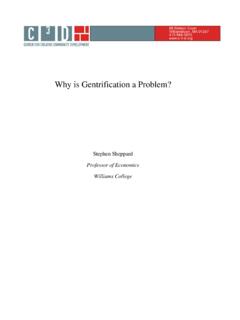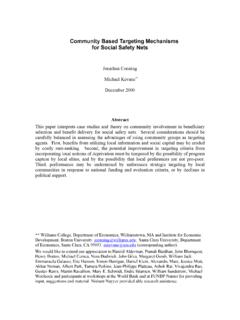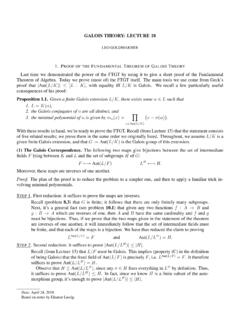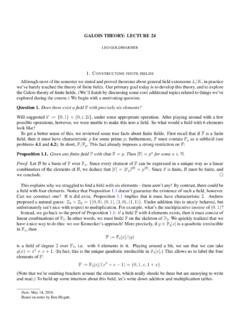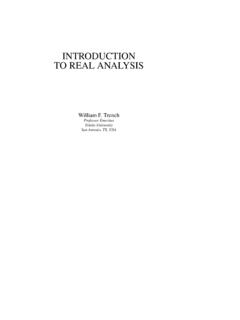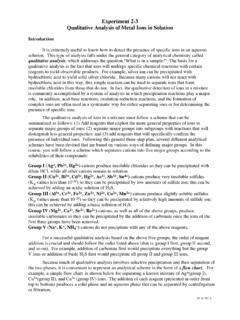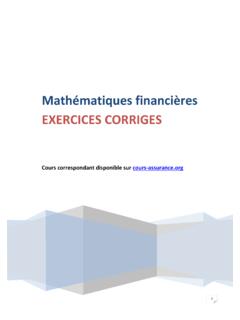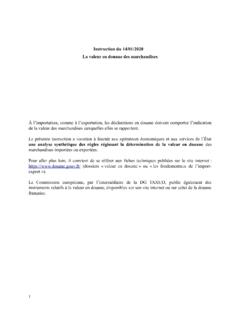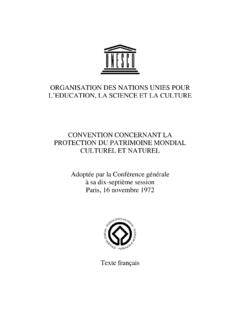Transcription of Definite Integrals by Contour Integration
1 UNIVERSITY OF BRISTOLD epartment of PhysicsLevel 3 Mathematical Methods 33010 (2009/2010)Definite Integrals by Contour IntegrationMany kinds of (real) definite Integrals can be found using the results we have foundfor Contour Integrals in the complex plane. This is because the values of contourintegrals can usually be written down with very little difficulty. We simply haveto locate the poles inside the Contour , find the residues at these poles, and thenapply the residue theorem. The more subtle part of the job is to choose a suitablecontour integral one whose evaluation involves the definite integral required.
2 Weillustrate these steps for a set of five types of definite 1 IntegralsIntegrals of trigonometric functions from 0 to 2 :I= 2 0(trig function)d By trig function we mean a function of cos and sin .The obvious way to turn this into a Contour integral is to choose the unit circle asthe Contour , in other words to writez=expi , and integrate with respect to .Onthe unit circle, both cos and sin can be written as simple algebraic functions ofz:cos =12(z+1/z)sin =12i(z 1/z)and making this replacement turns the trigonometric function into an algebraicfunction ofzwhose poles can be easily.
3 I= 2 0d 1+acos where 1<a<+1I= 11+a2(z+1z)dziz=2i dz2z+az2+aThe poles of the function being integrated lie at the roots of the equationaz2+2z+a= 0 at the pointsz =1a( 1 1 a2)1CZ+Z-Of the poles, onlyz+lies inside the unit circle, soI=2 iR+whereR+is theresidue atz+To find the residue we note that this is a simple pole and if we writethe integrand asf(z)=g(z)/h(z) the residue atz+is:g(z+)h (z+)=22i(az++1)=1i 1 a2 Hence the integral required is 2 / 1 a2 Type 2 IntegralsIntegrals such asI= + f(x)dxor, equivalently, in the case wheref(x) is an even function ofxI= + 0f(x)dxcan be found quite easily, by inventing a closed Contour in the complex plane whichincludes the required integral.
4 The simplest choice is to close the Contour by a verylarge semi-circle in the upper half-plane. Suppose we use the symbol R fortheradius. The entire Contour integral comprises the integral along the real axis from Rto +Rtogether with the integral along the semi-circular arc. In the limit asR the contribution from the straight line part approaches the required integralI, while the curved section may in some cases vanish in the limit. Note: when weC1C3C2R-Rchoose to split up the complete Contour into sections ( C1,C2, etc.)
5 We shall use thenotation (J1,J2, etc.) for the corresponding Contour Integrals . C1f(z) :I= + dx(x2+1)2can be found by these methods, because theintegral around the arc, which can bewritten as 0iRei d (R2e2i +1)2R 0iRei d R4e4i =iR3 0e 3i d clearly vanishes asR . Once again the way is clear for us to use the residuetheorem, and inspection of the function1(z2+1)2showsthatithaspolesatthe rootsofz2+ 1 = 0 i,ofwhichonlyz=+ilies in the upper half-plane. The order of the pole is established by noting that(z i)f(z)|z=iis infinite, while (z i)2f(z)|z=i=1(z+i)2= 14, so the pole is ofsecond to find the residue for the pole we have to use the general formulaR=1(m 1)!
6 Limz z0dm 1dzm 1(z z0)mf(z)wherem 2 in this case the simplest choice ism=N= 2, givingR= limz iddz{1(z+i)2}= i4 ConsequentlyI=2 i i4= /2 Type 3 IntegralsThis class is similar to the previous one, but with a trigonometric function in-volved in the integrand:I= + trig fnpolynomialdxIn this case we have to take special care over the choice of the complex function, inother words thecontinuationof the trigonometric function away from the real three functions cosz,(eiz)and(e iz) all have the same real parts on the realaxis, but are different elsewhere.
7 In particular, whenz=iRandR the firstand last become infinite, while the second tends to zero. Consequently the meth-ods described for Type 2 Integrals will work only if we adopt the second :I= + cosxdxx2+a2 For the reasons just described we find this by Contour Integration ofeizz2+a23and since in polar coordinateseiz=eircos e rsin the numerator tends to zero asrbecomes large everywhere in the upper half-plane where sin is positive. Using thesame D-shaped Contour as before, the semi-circular arc contributes arceizdzz2+a2= limR + 0eiziRei d R2e2i +a2=0 SoI=2 i Rwhere the sum is of the residues in the upper half-plane.
8 The functionhas simple poles atz= iaof whichz=+iais in the upper half-plane with residueR=(z ia)f(z)|z=ia=eizz+ia|z=ia= i2ae aSo finally, taking real parts,I= ae argument will clearly work whenever the integral around the semi-circle van-ishes. The previous discussion shows this is true for functions of the formf(z)=P(z)Q(z)eizwhereP, Qare polynomials inzand the order ofQis at least 2 greater than that ofP, because in the limit of largeR, the contribution from the arc will fall as 1/R(ora higher inverse power ).
9 If, on the other hand, the order ofQis just one higher thanthat ofP, it is not immediately clear what will happen. However, in such cases theexponential decrease ofe Rsin in the upper half-plane overwhelms everything elseand the arc integral still vanishes. This fact, which we do not have time to proveformally, is known as Jordan s Lemma and it makes Contour Integration a usefulmethod for a large class of Integrals , and you should know it and be ready to use itin appropriate 4 IntegralsA type of integral which brings in some new ideas is similar to Type 2 but witha pole of the integrand actually on the Contour of Integration .
10 As an example of asituation where this arises, consider the real integralI= + cosxxdxThe approach previously discussed would involve replacing cosx/xbyeiz/z,inwhich case the semi-circular arc would vanish by Jordan s lemma. However there isa problem, because cosx/xhas a pole at the origin, and the integrand diverges aswe approach the origin along the real axis either from positive or negative values ofz. To deal with this we introduce the concept of the Principal Value of a definiteintegral. In this we imagine that we exclude a smallsymmetricalrange of realzvalues around the pole, and take the limit as this excluded region shrinks to zerowidth.
